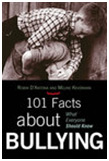New Book Debunks the Myths of Bullying
 Whether your child is beginning his or her first day of kindergarten, or starting that last year of high school, bullying is a reality every student will face.
Whether your child is beginning his or her first day of kindergarten, or starting that last year of high school, bullying is a reality every student will face.
“One hundred percent of children are touched by bullying as a victim, perpetrator or bystander,” says Dr. Meline Kevorkian, executive director of academic review at Nova Southeastern University in Fort Lauderdale, Fla. and author of book, “101 Facts About Bullying: What Everyone Should Know” (Rowman & Littlefield, September 2008).
“In a recent study, 77 percent of students said they have been bullied and 14 percent of those who have been bullied said they have experienced severe reactions to the abuse,” she says. “Bullying is a reality that must be recognized and addressed. It is not simply a part of growing up.”
The first “and most crucial” step to bullying prevention and promoting peace is to separate the myths and facts, she writes in the book, which breaks down what research says about bullying and its effects.
Some highlights:
- Â Children can be both bullies and victims. “Although there is a tendency to categorize, we must realize that students may be a victim in a given circumstance and a bully in another,” she writes. “Sometimes when a bullied student is otherwise unable to stop the bullying, the victim may in turn exhibit those behaviors to others.”
- Students who fight back are more likely to be victimized. “We should not tell students to fight back against bullies. The cycle of bullying and victimization is reinforced when the victim responds aggressively. Mediation between the bully and victim is not possible; in a true case of bullying, putting them together to work out their problems would simply revictimize the victim.”
- Adolescent bullies are often popular. “The popular kids are very likely to use their popularity in a negative way. They will use their status within the group to humiliate others. And because they tend to be psychologically stronger than their peers, they use that ability to control others. Bullies can enjoy a high social status.”
*Bullying can be a prelude to more serious bad behavior. “The evidence is clear that bullies, when allowed to continue, will escalate their behavior as they get older. Vandalism, shoplifting and truancy are all destructive aggressive behaviors. There’s also a direct correlation between substance abuse and gun violence and bullying behavior.”
* Even kids with high self-esteem can be bullies. “This is one of the most difficult myths about bullying to overcome,” she says. “Research indicates that self-esteem seems to be an indicator of intensified prosocial and antisocial tendencies. High self-esteem can mean that a student can be either a positive or negative leader. In other words, we cannot assume that a student who thinks well of him or herself is not a bully, because he or she can use that self confidence either to bully or defend victims.”
* Even bystanders suffer. “Elementary school children who witness bullying are at risk for long-term troublesome and depressive behaviors,” she says. “It causes stress, anxiety, apprehension and other types of physical responses in children. Research clearly indicates that children as young as five years who continually observe bullying that goes on unchecked or ignored by adults are at greater risk of becoming bullies themselves. ”
Source: Dick James Communication via Newswise
